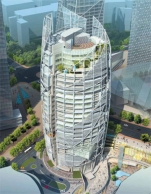The Multimedia Landmark

The new Yongsan International Business District (YI BD), which plan was developed by Daniel Libeskind (Studio Daniel Libeskind) will be the new heart of Seoul. With its cosmopolitan flair, economical power and urban sophistication, it will be comparable only to a few other city centers on the global stage.
The Tange building, (identified in the Master Plan as “C1-20”), will be a significant urban anchor at the very center of the YIBD. The architecture of The Tange Building is a metaphorical expression of the dynamic energy created by the Retail Valley and the building’s own diverse program. The Tange Building will have a strong relationship to the Retail Valley, to which it offers easy access. The building will mediate between Retail Valley and the surrounding office buildings. It also will demarcate the path from the Han River through the Retail Valley all the way to Yongsan Station.
The Tange Building provides a gross area of 58,400 m2 on 25 floors and at a height of 165 m. It is distinguished by a unique mixed-program that combines spaces for ‘learning, creating and communicating’. The building is comprised of educational institutions, a ‘synergy floor’ for events and exhibitions, a three-story fitness center, various regional headquarters for international companies, spaces for private clinics and a 3-star restaurant that opens up to the roof top terraces. Passing through the entrance visitors will step into a three-story atrium (3,000 sq. m.). According to the scheme from 3 to 6 floors will take educational center (9000 sq. m.), above will be located “Synergistic floor” total area of 3000 square meters. Fitness center will occupy floors from 8 to 10 (8,000 sq. m.), and then will be offices – 28 000 sq. m.
The uppermost floors (23 – 25 fl.) will be given to restaurants (7000 sq. m.), from where for visitors are provided inlets to the garden terraces, located on the roof and adjacent to restaurants open areas for maximum enjoying the open views of the river and the whimsical perpetrations of prominent architects. The Tange Building’s multi-facetted facade frame embraces the building’s aluminum-glass skin in a powerful, upward-spiraling motion. At night, the facade turns into a giant media wall displaying beautiful digital artwork. The facade has three basic functions: Shelter-Sustain-Communicate. The super-frame embraces the outer skin and is installed with Brise-Soleils for sun shading. These louvers will be also equipped with solar panels to generate energy.
The super frame also allows for a very efficient maintenance system. In addition the facade serves as a ‘communicator’. The super frame includes giant Media Wall that will display digital artwork that can be seen from far away. A main design concept is to take the energy of the Retail Valley and move it up to the top. The upwards spiraling, swirling facade is a metaphor for this. The Tange Building’s appearance at night has a tremendous visual impact on the Retail Valley and will give a strong sense of identity to the entire district. Thus, The Tange Building will be an instantly identifiable Landmark for the entire district and a symbol for YIBD’s mission to reach out to the world.
YIBD Block C1-20
Location: Seoul, Korea
Site Area: 9,734 sq. m.
Gross Floor Area: 58.400 sq. m.
Building Scale: 25 Stories above Ground, 1 Story below Ground, (5 Stories of External Use below Ground)
Building Height: 165 m
Architect: Tange Associates
Design: Paul Tange, Yasuhiro Ishino, Michael Thanner
Design Team: Kazuya Ishida, Tomo Osaki, Akira Inamoto, Antonio Bellonio, Kentaro Shiratani, Nobutaka Mori Client: Dreamhub LTD., Seoul Yongsan Development Co. Ltd, Seoul
Full version you can download here
 Materials provided by Tange Associates
Materials provided by Tange Associates


